Digital Camera Comparison: Superzoom vs. DSLR

Disclosure: The items being compared are based on cameras owned and paid for by myself and my wife. Links marked with (eBay⇒) or (Amazon⇒) are affiliate links. This means I get paid a small commission if you buy something after clicking on the links. This money helps to pay for the running of the website.
What type of camera is best for motorhome use? In a small van, storage can be limited – but at the same time, getting good photos of the places you visit and the things you see is often very important to travellers.
I’ll assume that you want to move beyond basic compact digital cameras. That being so, one type of camera that is as close to the perfect compromise as you might ever get is the current generation of superzoom digital cameras (Amazon⇒).
Superzooms are often styled like DSLR (Amazon⇒)(Digital SLR) models but are cheaper, smaller and lighter and have a permanently attached lens with an incredibly high level of optical zoom – current models offer 20x – 30x zoom and cost £300-£350.
Superzooms offer reasonably good image quality, full auto focus and are easy to use – so why did we make the move from a superzoom to a full-blown DSLR recently?
Good as superzooms are, for ultimate image quality (especially for large prints) and the challenge and satisfaction of taking a more active role in the creation of a photo, nothing compares to a DSLR.
We have now used both types of camera for a while and have come to a number of conclusions about the differences between the two types of camera and the advantages of each. I’ve summarised these below in the hope it may be useful for others facing the same choice.
Superzoom Cameras
| Pros | Cons |
| Easier to use | Harder to get really good or technically complex photos |
| Less to carry around – only a simple holster-type camera bag is needed | Lack of control over shutter speed and aperture |
| Easier to get good results | Smaller batteries and shorter battery life (our experience) |
| Fully automated focusing | Ultimately, image quality will not be as good as with a DSLR |
| Much cheaper | Limited choice of filters and other accessories. |
| Very wide zoom range from wide angle to telephoto (latest models are x30) |
DSLR Cameras
| Pros | Cons |
| Ultimate flexibility with multiple lenses and separate flash units | Much more expensive |
| Greater potential for really high quality, large or technically complex photos | Harder to get good results than a superzoom |
| Larger batteries with impressive battery life (the stock battery in our Canon EOS 550D |
More to carry around – for multiple lenses, a bag, rather than just a case, is necessary, and the camera itself is much heavier. |
| Choice of full auto, partial auto and full manual focusing options – manual control of aperture and shutter speed is possible to achieve specific results | Complexity and cost of needing multiple lenses |
Conclusions
Current superzoom cameras are highly competent, all-in-one packages that can meet and exceed most people’s requirements and are relatively affordable and easy to use. They combine point-and-shoot simplicity with reasonably good image quality.
For a DSLR to be worth the extra cost and complexity, you have to want to learn to use it and have some interest in taking photos – otherwise you may be frustrated by the extra effort required.
You will also need to budget for at least two lenses in order to get the same zoom range as a superzoom camera (although cropping an image down from a high resolution can help compensate for lack of zoom) – and you need to be willing to it all around with you.
Check out Superzoom Cameras (Amazon⇒) and DSLR cameras
(Amazon⇒) on Amazon.
